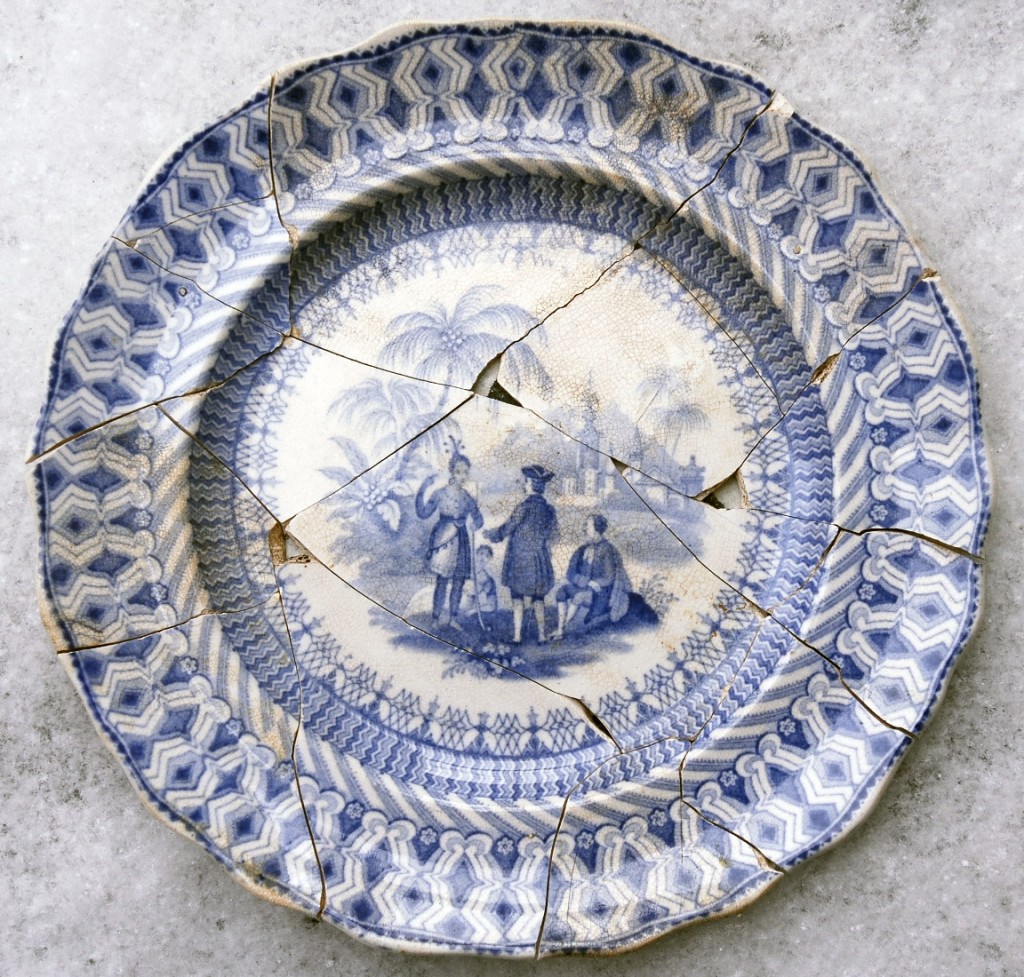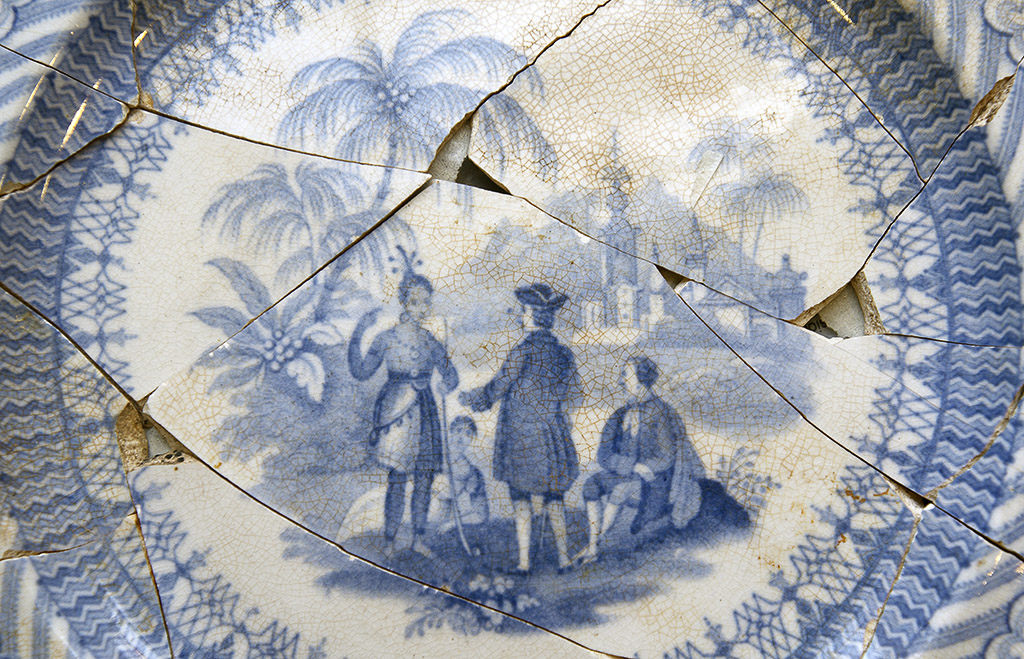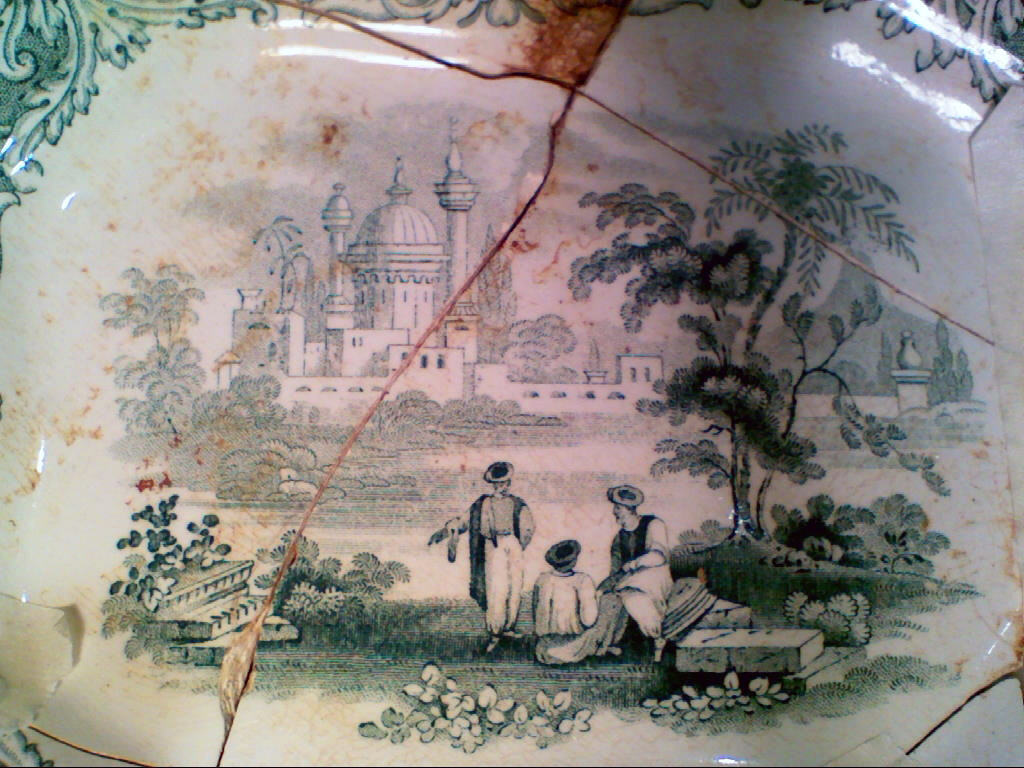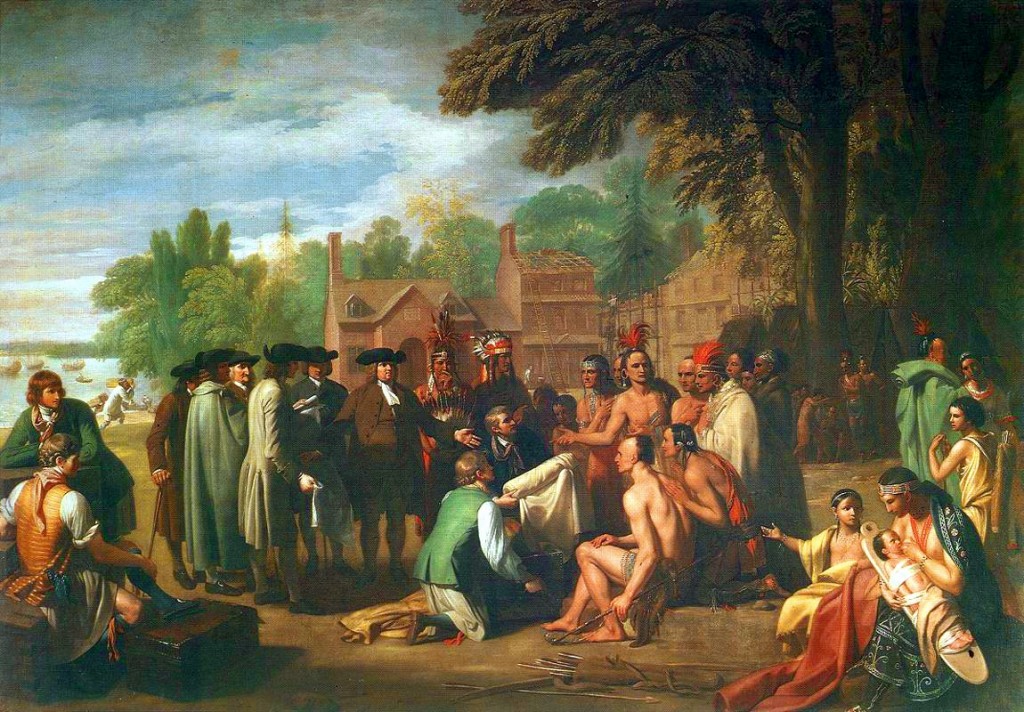March 2015 – Artifact of the Month
To Artifact of the Month Index
To PAF Home
Tropical Philadelphia

Transfer printed plate recovered from the National Constitution Center Site in Independence National Historical Park in Philadelphia, Pennsylvania.
Image Source: Feature 148 (F148C0221), courtesy of Independence National Historical Park.
Romantic depictions of Lenape Indians and William Penn signing the Treaty of Shackamaxon beneath the spreading branches of an ancient elm tree abound. The event itself may well be apocryphal, historians have yet to uncover firm evidence that such a meeting ever took place at Shackamaxon, now the Fishtown neighborhood of Philadelphia. Never the less, the purported event assumed mythical status soon after its supposed occurrence in 1682. Beginning in the eighteenth century, and continuing to the present, treatment of the meeting in both literature and the graphic arts celebrated the signing as a symbol of the peaceful founding of the Quaker
colony–an event sharply in contrast to the contentious and often bloody events in adjacent colonies.
Benjamin West’s majestic painting, William Penn’s Treaty with the Indians (above), completed in 1771, served to fix the event in public memory and imagination. Like others that followed, West’s work paints an idyllic picture of an iconic event; in so doing the depictions serve as an antidote that veils the brutal, enduring, violence of the colonial encounter.
The Philadelphia Archaeological Forum’s Artifact of the Month for March illustrates the continuing popularity of this romantic view of Pennsylvania’s founding. Recovered in Independence National Historical Park during the archeological excavations that preceded construction of the National Constitution Center, this fragmentary, 7 1/2″ diameter dinner plate was found in an abandoned and filled privy pit (outhouse), along with nearly 12,000 other ceramic fragments and thousands of other artifacts.

The plate was made in Staffordshire England by Thomas Godwin sometime between 1834-1854. The pattern is called “W Penns Treaty”, and while the foreground grouping of figures certainly appears to illustrate the familiar treaty scene, a closer examination reveals some surprises. The colonial structures of Shackamaxon village that serve as the backdrop in West’s painting have been replace on the plate by a group of vaguely mid-eastern or Asian buildings, with towering peaks behind them. Similarly, the stately elm is gone and in its place is a palm tree! That tropical palm tree is sure to rise the eyebrows of anyone who knows Philadelphia, and it will certainly come as a shock to local residents who have had to endure the icy cold winter of 2015.
This odd juxtaposition of decorative elements on the plate tells us a great deal about the production and marketing of household ceramics in the first half of the Victorian era. One of the most notable advances in the industrial production of these ubiquitous commodities was the development in late eighteenth century England of transfer printing. This process allowed an image engraved on a metal plate to be transferred to the surface of a piece of ceramic and, as a result, made it practical and economical to mass produce tableware decorated with intricately detailed decoration. By the 1830s English factories were producing and exporting huge
quantities of this type of ware decorated with a seemingly infinite variety of patterns.
Particularly popular were scenes of exotic peoples and places. Patterns such as “Grecian Scenery”, “Palestine”, “Aladdin”, “Eastern Scenery” and countless others features fanciful buildings, exotically dressed people and plants and animals that were alien and wondrous, at least to British eyes. They evoked other peoples and strange places.
Transfer printing allowed for the mass producing of these wares and also made it easy, and all but irresistible, for manufacturers and engravers to copy decorative motifs used on one engraving to another for reuse. The result could sometime result in fanciful– or downright weird– combinations. While the form and composition of the scenes depicted were often quite formulaic, the decorative elements could be combined and arraigned to provide variety.
Compare, for example, the Penn treaty pattern with another transfer printed pattern recovered at the NCC Site (see below). This pattern, represented by portions of a set of dishes decorated with a design called “Thessalian”, were recovered from a different privy. The view on these objects is similar in general composition to our treaty plate: a group of foreground figures against a background featuring buildings, with trees and foliage in the middle ground. However, rather than William Penn and a contingent of Lenape, the Thessalian pattern features turbaned gentlemen in the foreground, and the buildings behind them are more clearly eastern in style (see below). Apparently, however, nothing signified a foreign land to nineteenth century British manufacturers and consumers like the palm tree did. Both scenes, the one purportedly a view of central Greece bordering the Aegean Sea and the other of Philadelphia both feature palm trees!

Transfer printed plate excavated from the National Constitution Center Site, in Independence National Historical Park. Image Source: Feature 190 (F190C0001), courtesy Independence National Historical Park.
Information for this Artifact of the Month was contributed by Jed Levin of Independence National Historical Park.
To Artifact of the Month Index
To PAF Home
by admin
